Snapdragon 855 Benchmarks: Watch Your Back, iPhone
We got to test Qualcomm's Snapdragon 855 mobile processor and saw big jumps in performance. Here's how phones running the Snapdragon 855 will compare to the iPhone.
Editors' Note: Updated at 2:16 p.m. ET to include additional test results.
The A12 Bionic processor inside Apple's latest iPhones may be the fastest mobile processor we've tested to date. But it should be hearing the footsteps from Qualcomm's Snapdragon 855, as that new chipset is rapidly closing the performance gap.
The 855 is widely expected to power the upcoming Samsung Galaxy S10 in the U.S. which launches Feb. 20.
We've had a chance to put a device running the Snapdragon 855 through a series of benchmark tests. And while the A12 maintains an edge over Qualcomm's new processor, the gap is the narrowest its been in some time. Qualcomm's latest chip also continues to enjoy a big advantage over the A12 when it comes to graphics. And of course, that translates to big gains over Qualcomm's previous top-of-the-line mobile chipset, the Snapdragon 845, which powers most of 2018's top phones.
MORE: Here Are the 10 Best Phones Available
Then again, Qualcomm promised as much when it unveiled the Snapdragon 855 in December. At the time, Qualcomm said the Kryo 485 CPU in the Snapdragon 855 would deliver a 45 percent performance improvement over the Snapdragon 845. The Adreno 640 GPU was expected to offer a 20 percent boost to graphics. That translates to the biggest performance boost ever for a Snapdragon update, according to Qualcomm.
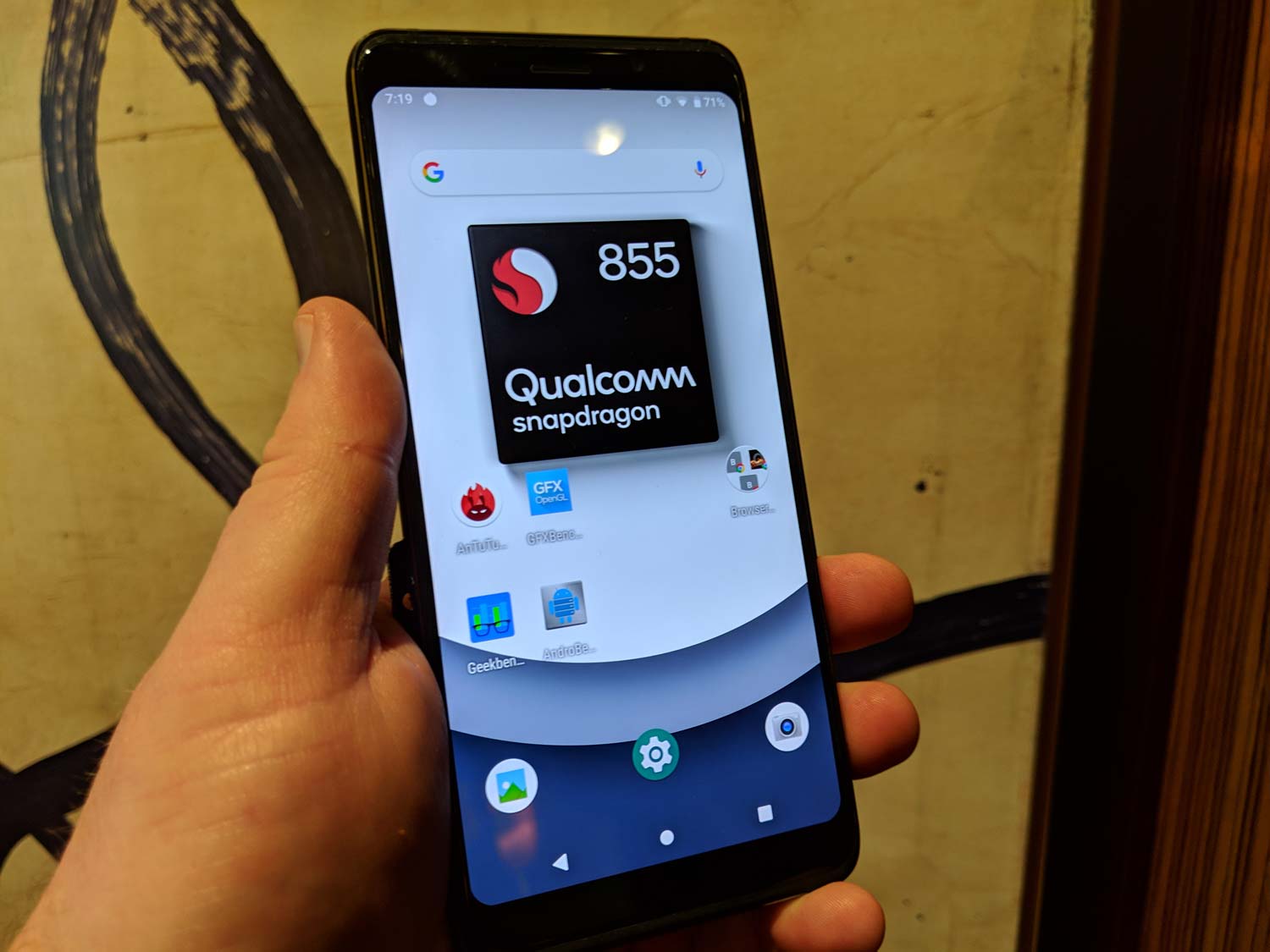
Put another way, Qualcomm senior director for product management Travis Lanier said that the Snapdragon 855 was like adding the performance of an Snapdragon 800 chipset onto last year's 845. So it's no surprise to see the gains we saw when putting the new processor to the test.
How we tested
We ran a series of synthetic benchmarks on a Qualcomm-supplied reference device powered by a Snapdragon 855 mobile processor. Our test device had a 5.99-inch 2880 x 1440 AMOELD display and included 6GB of RAM. We conducted tests at the invitation of Qualcomm during a benchmarking session at CES 2019, comparing the results we recorded to other flagship smartphones we tested in the past year.
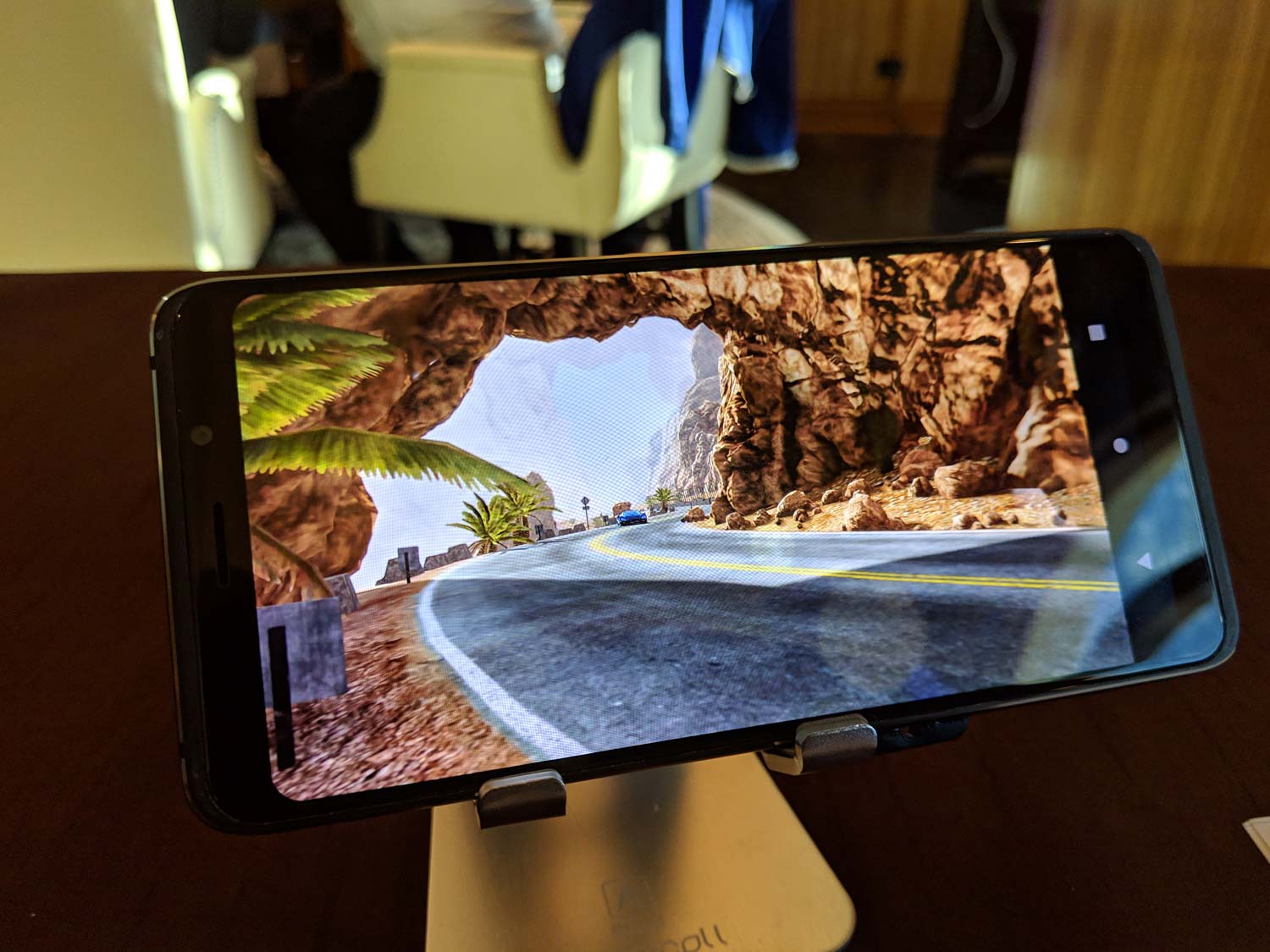
Our benchmark numbers come from a reference device, not an actual smartphone, so numbers may vary once device makers start releasing phones powered by the Snapdragon 855. But our initial test results give us a better idea of what to expect when those phones start arriving, possibly as soon as February when Samsung takes the wraps off the Galaxy S10.
Geekbench 4: Closing the gap with iPhone
Geekbench 4, which measures overall performance, has long been Apple's opportunity to flex the dominance of its in-house designed mobile processors over chipsets from other companies. When we tested the A12 Bionic powering the iPhone XS last fall, that phone produced a score of 11,420 — far ahead of any phone running Qualcomm's Snapdragon 845 and Huawei's Kirin 980.
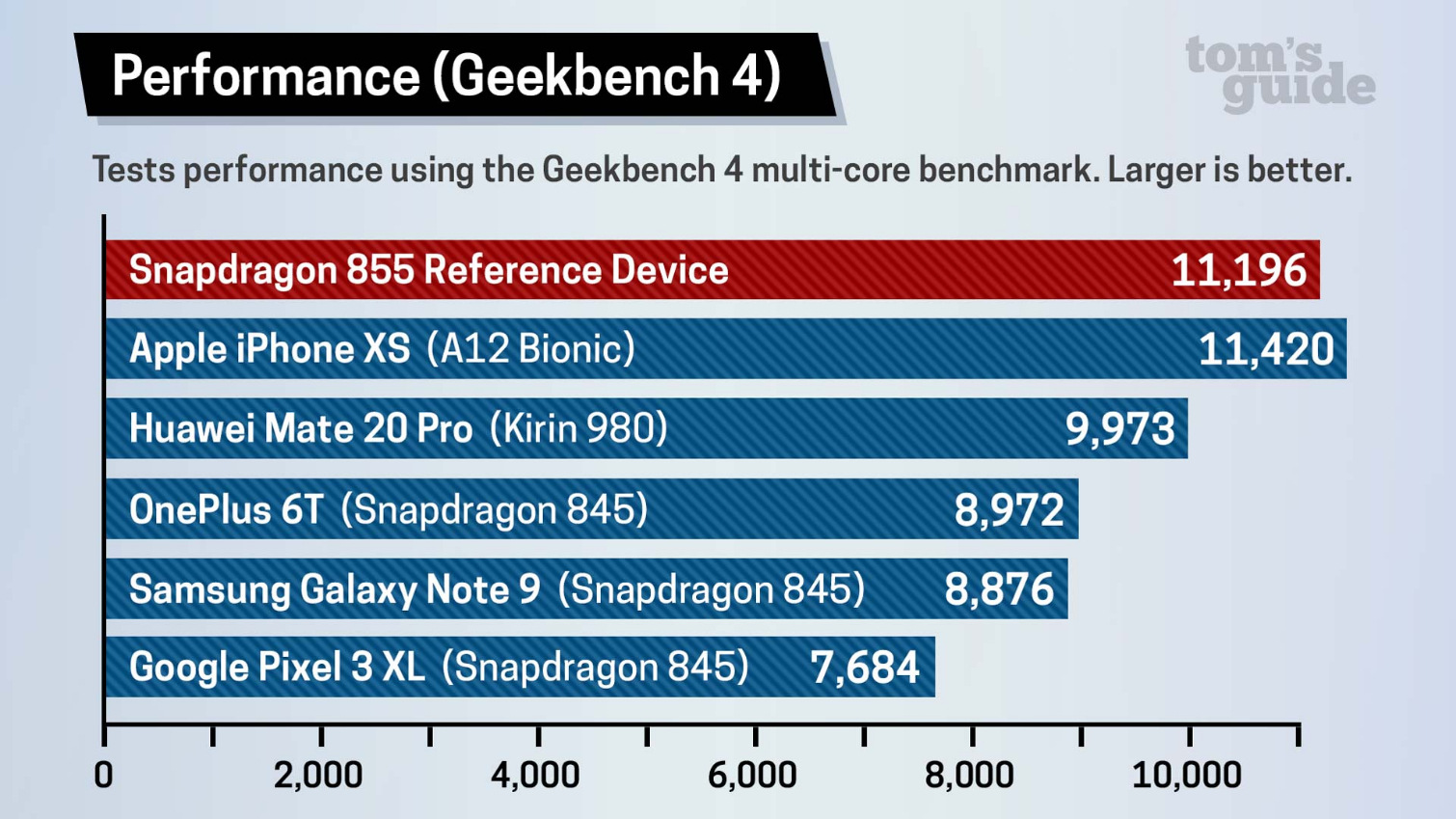
That's changing with the Snapdragon 855. When we ran Geekbench 4 on our reference device, we saw Qualcomm's new chipset post a multicore score of 11,196. That's a 25 percent improvement over the 8,972 Geekbench 4 result of the OnePlus 6T, a top-performing Snapdragon 845-powered device that also has the benefit of 8GB of RAM. Our Snapdragon 855 test unit also beat the Kirin 980-powered Huawei Mate 20 Pro's 9,973 score.
Geekbench 4 Scores
| Phone | Processor | Score |
| Apple iPhone XS | A12 Bionic | 11,420 |
| Qualcomm Snapdragon 855 Reference Device | Snapdragon 855 | 11,196 |
| Huawei Mate 20 Pro | Kirin 980 | 9,973 |
| OnePlus 6T | Snapdragon 845 | 8,972 |
| Samsung Galaxy Note 9 | Snapdragon 845 | 8,876 |
| Google Pixel 3 XL | Snapdragon 845 | 7,684 |
But the key takeaway here is how narrow the gap is between the iPhone XS and our Snapdragon 855-powered device. There's only a 2 percent difference in Geekbench 4 scores — a far cry from the 26 percent advantage the iPhone XS enjoys over the Snapdragon 845-powered Galaxy Note 9.
Of course, those are just multicore scores. In single-core testing, the A12 continues to enjoy an advantage over Qualcomm's latest chip. The Snapdragon 855 we tested produced a Geekbench 4 single-core score of 3,552, which doesn't keep up with the 4,701 score our iPhone XS produced.
Video Editing Test
Apple's A12 chip continues to enjoy an advantage in our real-world test where we use the Adobe Premiere Clips app to transcode a 2-minute 4K video to 1080p. The Snapdragon 855-powered device struggled with this test, taking 3 minutes, 29 seconds to complete the task. That's faster than the OnePlus 6T (3:45), but not as fast as Google's Pixel 3 XL (2:42), both of which use the Snapdragon 845. And Apple continues to blow away the competition here, transcoding the video in a blazing 39 seconds.
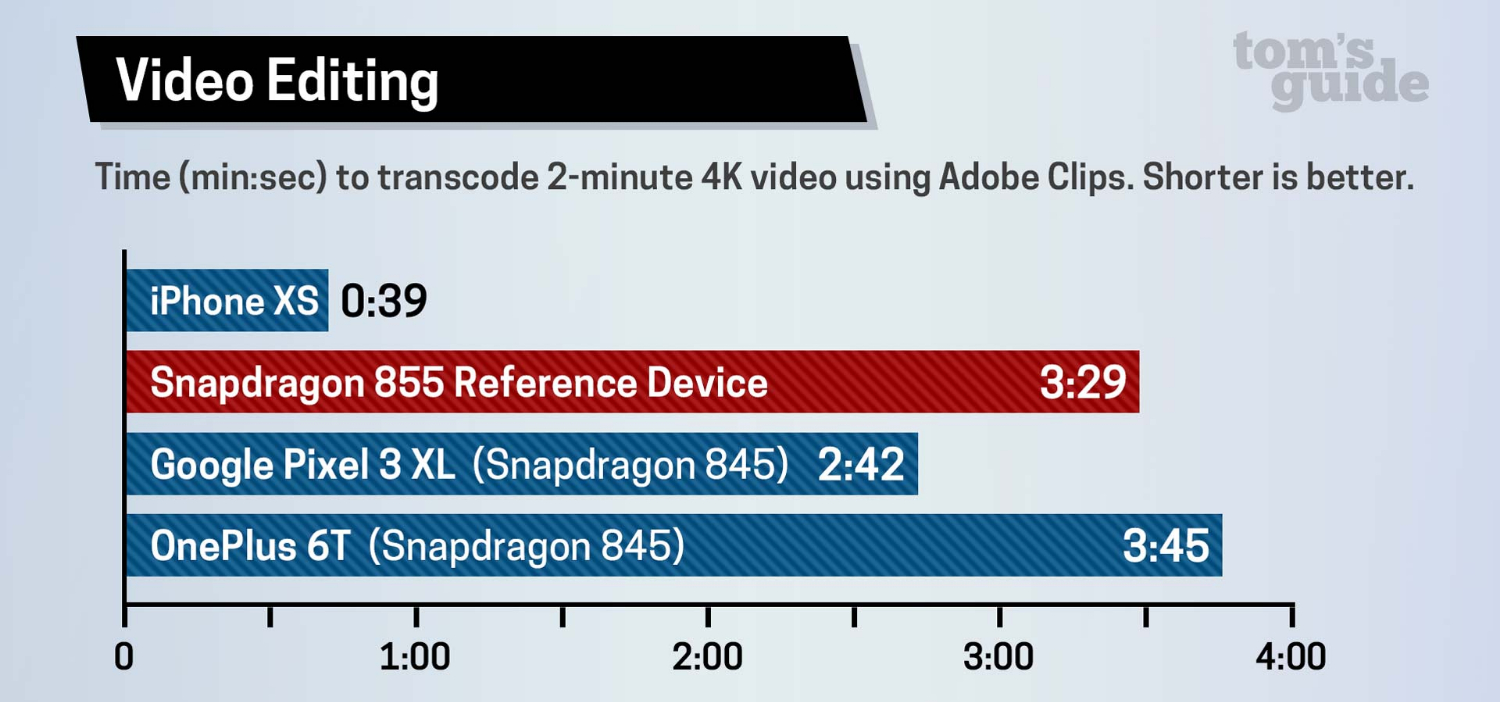
Qualcomm counters that its new chipset performs well in other real-world settings, pointing to its own tests that indicate apps like Gmail, Google Maps, Facebook Twitter, WeChat, Instagram and YouTube open faster on the Snapdragon 855 than they do on other 7-nanometer mobile processors. (That would be the A12 Bionic and Kirin 980.)
Adobe Premiere Clips Results
| Phone | Processor | Time (Mins:Secs) |
| Apple iPhone XS | A12 Bionic | 0:39 |
| Google Pixel 3 XL | Snapdragon 845 | 2:42 |
| Qualcomm Snapdragon 855 Reference Device | Snapdragon 855 | 3:29 |
| OnePlus 6T | Snapdragon 845 | 3:45 |
Graphics: Snapdragon's still the best
Qualcomm's Snapdragon platform has traditionally been a strong performer when it comes to graphics benchmarks, with last year's Snapdragon 845-powered smartphones outscoring Apple's iPhones on many graphics tests. Qualcomm expects that to continue with its new chip. "The Snapdragon 855 delivers the industry's best sustained gaming performance," Lanier said.
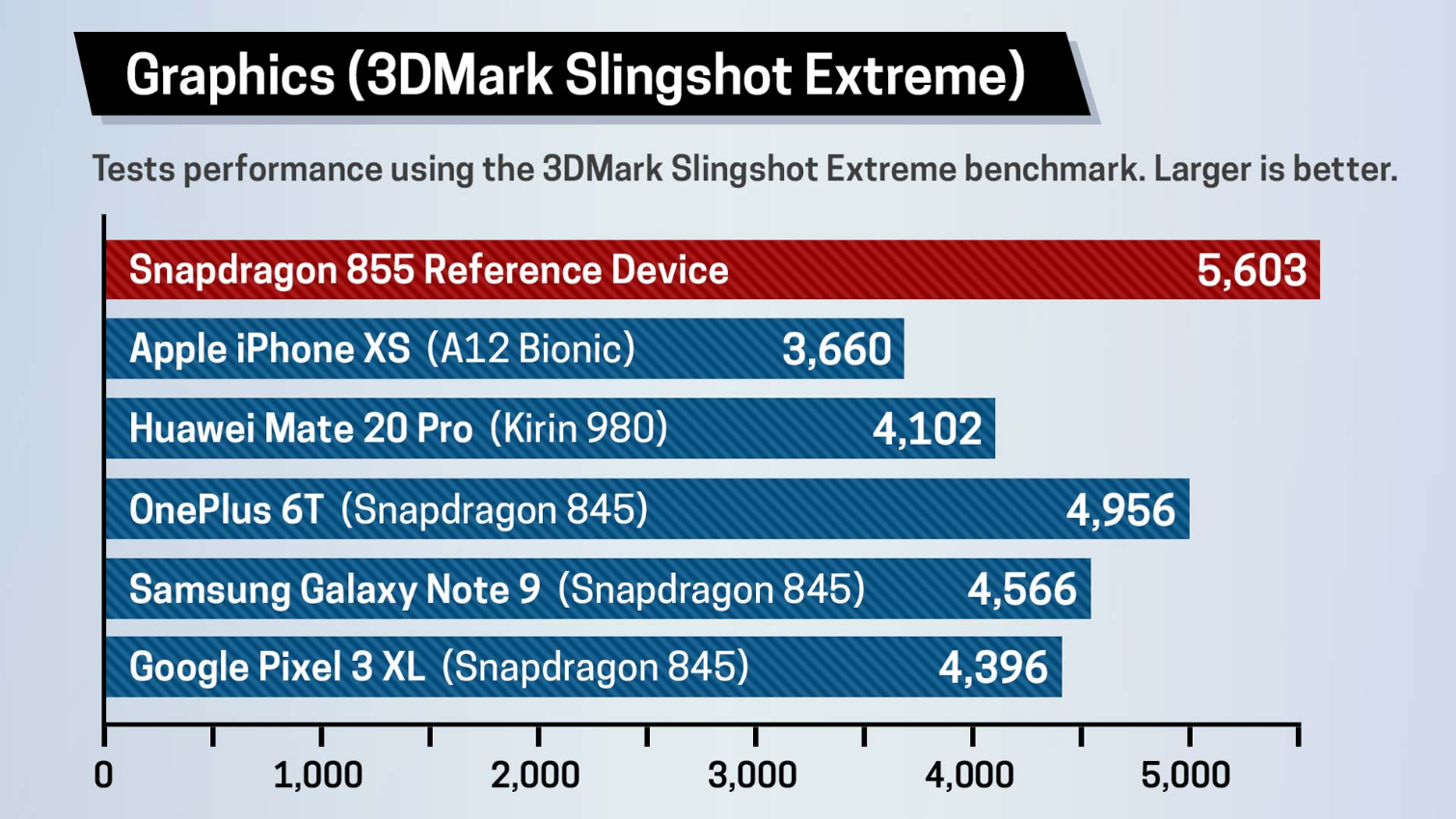
Our testing bears that out. Running 3DMark's Slingshot Extreme graphics benchmark on our reference device, we recorded a score of 5,603 for the Snapdragon 855. That blows away the 3,660 result we recorded for the iPhone XS. It's also better than what we saw from the Kirin 980 powering the Mate 20 Pro (4,102) and better than every Snapdragon 845 device we tested. The OnePlus 6T had one of the best results on Slingshot Extreme at 4,956, and that's still off the pace set by the Snapdragon 855.
Slingshot Extreme Scores
| Phone | Processor | Score |
| Qualcomm Snapdragon 855 Reference Device | Snapdragon 855 | 5,603 |
| OnePlus 6T | Snapdragon 845 | 4,956 |
| Samsung Galaxy Note 9 | Snapdragon 845 | 4,566 |
| Google Pixel 3 XL | Snapdragon 845 | 4,396 |
| Huawei Mate 20 Pro | Kirin 980 | 4,102 |
| iPhone XS | A12 Bionic | 3,660 |
We typically don't focus too much on GFXBench's tests when comparing devices, but they do illustrate the strides Qualcomm has made with the Snapdragon 855. Running GFXBench's ES 3.1 Manhattan 1080 Offscreen benchmark, our Snapdragon 855 device recorded 60 frames per second, while it got up to 152 FPS on the ES 2.0 T-Rex 1080 Offscreen benchmark. Those numbers outpaced the iPhone XS's respective scores of 44 FPS and 149 FPS. It's also better than what Pixel 3 XL (60 FPS and 152 FPS) did on those two tests, too.
Browser Tests
We also ran a pair of browser-based benchmarks on the Snapdragon 855 device to get a sense of how the new mobile processor affects performance. On Octane 2.0, which measures a JavaScrip engine's performance, the Snapdragon 855 device scored 24,855 — a 46 percent improvement over the 17,012 score turned in by the Pixel 3 XL's Snapdragon 845 processor.
Jetstream 1.1, another JavaScrip-based test for measuring browser performance, saw the Snapdragon 855 score 116.73. That topped the Pixel 3 XL's 87.35 score in our testing.
Qualcomm is promising improved AI performance with the Snapdragon 855, thanks to a fourth-generation AI engine that draws on improvements to both the Kryo CPU and Adreno GPU in addition to improvements to the Hexagon digital signal processor. That DSP features double the number of core vectors as the Snapdragon 845, and a redesigned tensor accelerator promises a 3x speed improvement over last year's processor.
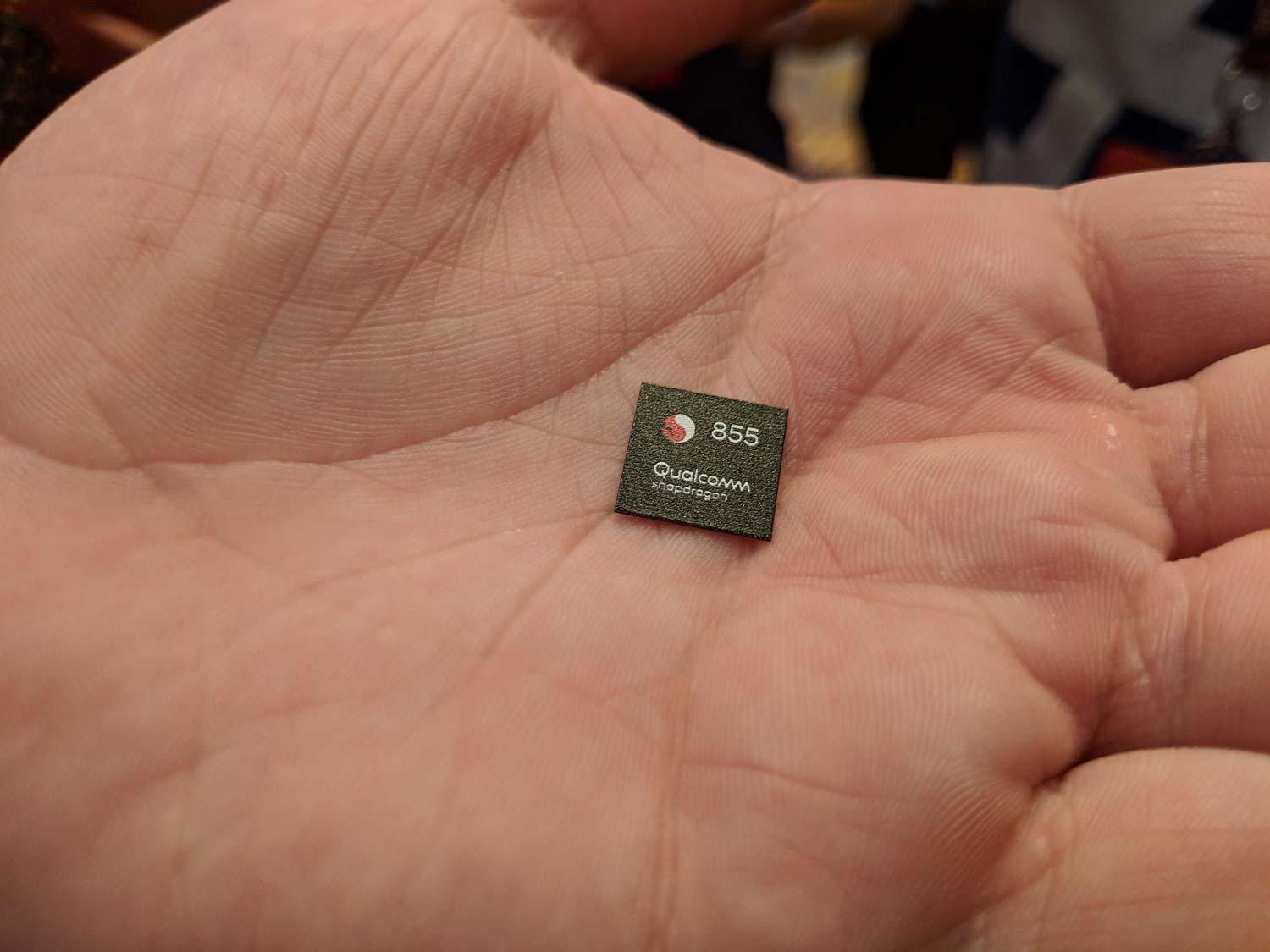
We're still wrapping our heads around how best to benchmark AI performance. At its testing session, Qualcomm showed off phones running several different AI benchmarks. The most noteworthy one to us was the Ludashi AIMark v1 benchmark, where the Snapdragon 855 was posting similar scores to Apple's A12 Bionic-powered phones while outperforming a Kirin 980 device.
We won't be able to gauge other promised Snapdragon 855 improvements until we lay our hands on a phone running on the new mobile processor. The 855 includes Qualcomm's X50 5G modem, and we won't be able to see how that performs until there are 5G networks on which to test it; until then, we can put the chipset's X24 LTE modem to the test to see if it delivers faster data speeds.
The Snapdragon 855 features a new Spectra 380 image signal processor as well, with computation features built right into the ISP instead of offloading them to another part of the chipset. That's expected to boost the speed of computational tasks performed by the phone's camera, and it should increase power efficiency as well. But testing features like that are beyond what we can do in our time benchmarking a Snapdragon 855 reference device.
Outlook
We don't officially know when we'll start seeing phones running on a Snapdragon 855. Royole's foldable FlexPai phone is supposed to use the chipset, though that phone is only available for pre-order. OnePlus has committed to building a 5G-ready phone using the Snapdragon 855, but it's unclear when that phone will debut. Samsung is holding a Feb. 20 event where the Galaxy S10 should make its debut, and that phone has traditionally featured Qualcomm's latest mobile processing platform. If history is any guide then, a device should be in hour hands by early March.
When we do finally get our hands on a shipping product using the Snapdragon 855, we can expect better overall performance than what we've previously seen from Android devices. More importantly, we should have a phone that can finally give the best of what Apple has to offer a run for its money in terms of performance.
Credit: Tom's Guide
Sign up to get the BEST of Tom's Guide direct to your inbox.
Get instant access to breaking news, the hottest reviews, great deals and helpful tips.
Philip Michaels is a Managing Editor at Tom's Guide. He's been covering personal technology since 1999 and was in the building when Steve Jobs showed off the iPhone for the first time. He's been evaluating smartphones since that first iPhone debuted in 2007, and he's been following phone carriers and smartphone plans since 2015. He has strong opinions about Apple, the Oakland Athletics, old movies and proper butchery techniques. Follow him at @PhilipMichaels.

